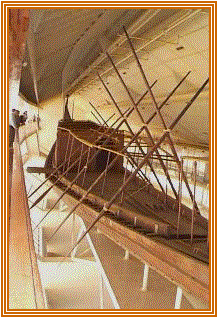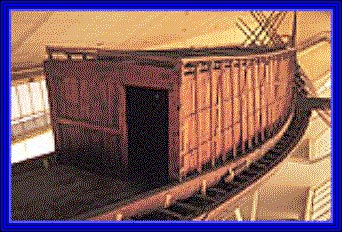Ancient Ships: The Ships of Antiquity
The Solar Barque of Khufu 4th Dynasty 2550-2528 BCE
Egypt had woods as a resource but the quality of
the native woods for shipbuilding was minimal. This shortage of
vital materials required that the Egyptians trade with regions with
higher quality timber resources. The ancient cities of the Lebanese
coast were known for large timbers harvested from the Cedars of
Lebanon
"Song Of The Cedars". The Egyptians created
trade alliances with the city-states of this region in order to
acquire the needed timbers, shipbuilding and seafaring technologies.
| A stamp issued by the modern Egyptian government
featured this illustration of the Solar Barque of Khufu |
|
 It
is known that as far as back as 3200 B.C., the people of Byblos
on the modern Lebanese coast were harvesting cedar trees in the
mountains of Lebanon, to be shipped to Egypt and Mesopotamia for
use in building ships and for making structural elements in buildings.
In return, the Phoenicians established trading alliances and brought
back, grain, paper, gold, ivory, copper, and turquoise and other
trade goods from the Nile Valley and Sinai. The Egyptian culture
was trading to the south with Nubia, Punt and Kush to provide a
trade link for many of these goods to the Northern regions.
Canaanite ceramic pieces have been found in Egyptian tombs dating
back to 2999 B.C. The importance of the evidence for early trade
between these two cultures for the purpose of creating ships cannot
be underestimated. This trade relationship and the importance and
influence of the ship building technologies of the Phoenicians would
continue and spread for another 2000 years. It
is known that as far as back as 3200 B.C., the people of Byblos
on the modern Lebanese coast were harvesting cedar trees in the
mountains of Lebanon, to be shipped to Egypt and Mesopotamia for
use in building ships and for making structural elements in buildings.
In return, the Phoenicians established trading alliances and brought
back, grain, paper, gold, ivory, copper, and turquoise and other
trade goods from the Nile Valley and Sinai. The Egyptian culture
was trading to the south with Nubia, Punt and Kush to provide a
trade link for many of these goods to the Northern regions.
Canaanite ceramic pieces have been found in Egyptian tombs dating
back to 2999 B.C. The importance of the evidence for early trade
between these two cultures for the purpose of creating ships cannot
be underestimated. This trade relationship and the importance and
influence of the ship building technologies of the Phoenicians would
continue and spread for another 2000 years.
In 1954, archaeologists found Cheopís (Khufu) funerary
barge at Giza in a chamber beneath his pyramid. The barge was made
of Lebanese cedar wood and faint scent of the cedar was still in
the grain at the time of its discovery.
The boat's 1,224 separate components
included cedar wood planking and oars, ropes of halfa grass, wooden
dowels and battens, and copper staples. Its near-perfect preservation
allowed conservators to reconstruct the 144-foot-long craft, which
is now housed in a museum built over the pit where it was found.
The timbers in the hull are bound together by rope and not nailed
or pinned together. Modern rope was used during its re-construction,
but its timbers are 95 percent original.
 As
you observe this composite set of images, you'll see the boat's
12 oars, ten along the sides and two larger ones at the stern. The
blades were insufficient to move a vessel of this size and were
either ornamental or used for steering only. The high, curving prow
and stern resemble those of papyrus boats common in ancient Egypt.
Notice also the cabin and canopy amidships, which were originally
covered in rush matting. As
you observe this composite set of images, you'll see the boat's
12 oars, ten along the sides and two larger ones at the stern. The
blades were insufficient to move a vessel of this size and were
either ornamental or used for steering only. The high, curving prow
and stern resemble those of papyrus boats common in ancient Egypt.
Notice also the cabin and canopy amidships, which were originally
covered in rush matting.
This ship demonstrates a tremendous investment
of resources and technical skill. It is representative of the effort
to which the Egyptians would have gone to in order to construct
other ships, those ships needed to transport materials for buildings
and monuments and to establish trade. It is safe to assume
similar efforts were made to create the more utilitarian vessels.
One of the greatest technologies used to build
the great pyramid is often overlooked because of its hidden quality.
The King's Chamber at the central core of the pyramid
is built from granite blocks (diorite) that was quarried near Aswan,
This means that some of these blocks which reach wieghts of over
eighty tons had to be tranported by barges nearly 300 miles down
the Nile River Valley and off loaded from the barges and placed
at the core of the Great Pyramid.
This implies the Egyptians had a very real and
practicle understanding of the law of specific gravity and could
engineer and build barges that could transport these blocks. This
accomplishment is not an easy feat. The shear maginitude of the
task would be difficult even in modern times.
It is understood from the archeological record
that the quarrying of great blocks and their tranportation is a
technology the Egyptias traded to their suppliers of timbers for
these barges. The area of Byblos on the Lebanese coast shows evidence
of the trade of cedar timbers for ths the quarry technologies.
This points to the longstanding relationships of
trade, transportation and technologies in the ancient world.
Previous |
Next | Table
Of Contents

|
